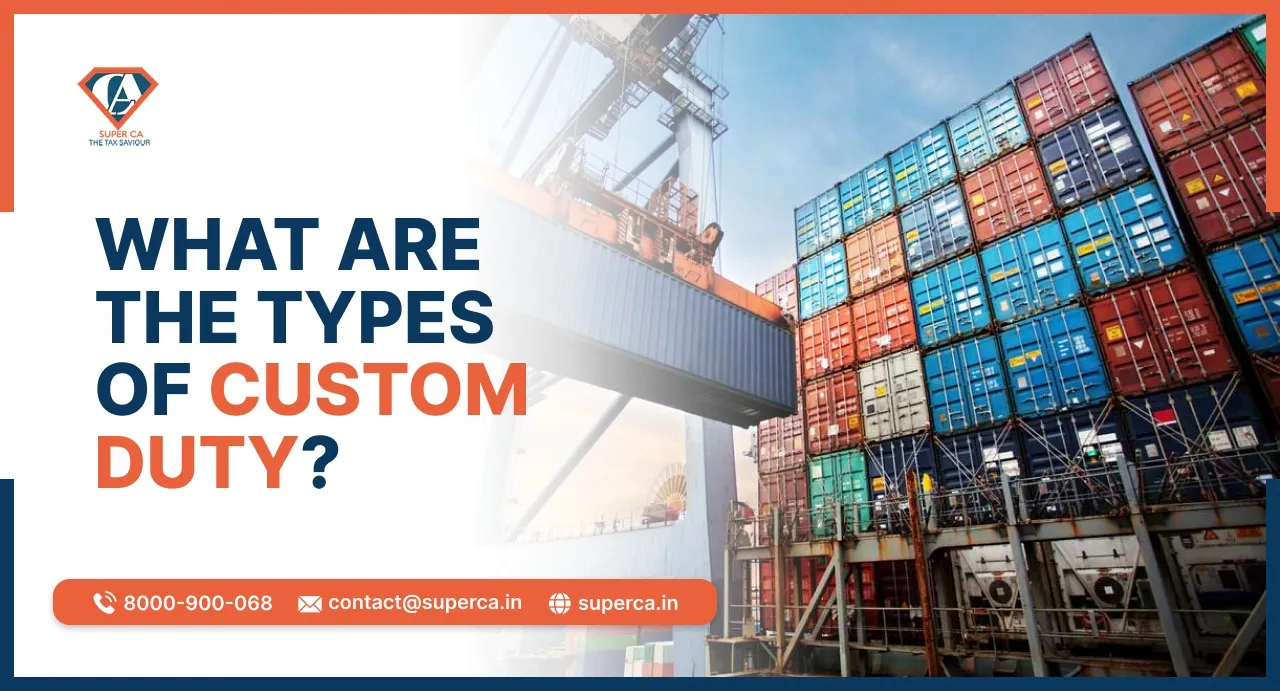What are the types of Custom Duty? Explained
- Posted By SuperCA
- On 09 July

The tax that is levied on those goods which will be transported across the international borders, is referred to as customs duty. The main aim of imposing customs duty was to ensure the safety of the economy, jobs, environment, residents and various other factors of each of the nations. This was done by controlling and regulating the transportation and movement of goods, mainly the movement of restricted or prohibited goods, internationally. The various types of customs duty have been explained below:
Basic Customs Duty
Basic customs duty is the duty/tax that is levied at a specified rate on the value of the goods. This tax is fixed at a particular rate of ad-valorem basis. This tax was first imposed in 1962 and it has been amended ever since from time to time. The basic customs duty is now regulated by the Customs Tariff Act of 1975. Any goods can be exempted from tax according to the central government.
Countervailing Duty(CVD)
The Countervailing Duty or the CVD is levied by the central government at the time when the country pays subsidy to those exporters who export goods to India. This amount of tax is equal to the subsidy that is paid by them. This tax is applied under Section 9 of Customs Tariff Act.
Special CVD or Additional Customs Duty
To equalise local taxes such as VAT, service tax and various domestic taxes with imports, an additional customs duty is levied on the goods that are imported. Therefore, it can be said that the special countervailing duty is imposed in order to bring imports and manufactured goods on an equal track. This helps in promoting fair competition and trade in India.
Safeguard Duty
In order to ensure that the domestic industries of India remain unharmed, a safeguard duty is levied. The interest of our local domestic industries is safeguarded by the imposing of the safeguard duty. The safeguard duty is computed on the basis of the loss that the local industries suffer.
Anti-Dumping Duty
It is also seen that various large manufacturers from foreign countries often export goods at quite low prices. The purpose of such dumping could be performed to cripple domestic industries or to get rid of the stock that they have in excess. This process is referred to as dumping. To prevent this act of dumping, the central government has the power to levy the anti-dumping duty under Section 9A of the Customs Tariff Act. The act of levying such an anti-dumping act is allowed as per the guidelines of the WTO agreement. This duty can only be imposed if there is an Indian industry which manufactures ‘like articles/products’.
National Calamity Contingent Duty
The national calamity contingent duty is levied under Section 129 of the Finance Act. The goods on which this tax is imposed include tobacco, pan masala or any other items that may prove to be harmful for the health of individuals. The rate of this tax may vary from 10% to 45%. Also, different rates are levied on the basis of different reasons.
Education Cess on Customs Duty
Education cess is imposed as the percentage of the total taxes of customs. In case the goods have been exempted from taxes or have zero chargeable tax or have been cleared without paying any tax under the processes like the clearance under bond, then, no cess will be levied.
Protective Duties
The Tariff Commission was established under the Tariff Commission Act, 1951. If the Central Government is content and a recommendation of the Tariff Commissioner is available, then an instant action is required in order to safeguard the interests of the Indian Industry. Then, under Section 6 of the Customs Tariff Act, a protective customs duty at the recommended rate is levied.
Conclusion
In this blog, we came to know about customs duty and the various types of Customs duty like the basic customs duty, the countervailing duty, the additional customs duty or the special CVD, the safeguard duty, the anti-dumping duty, the national calamity contingent duty, education cess on customs duty and the protective duties.





